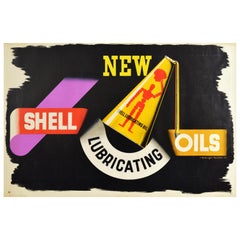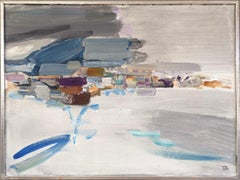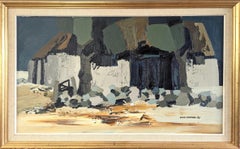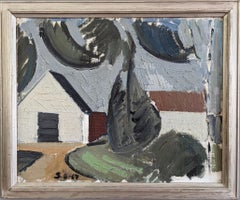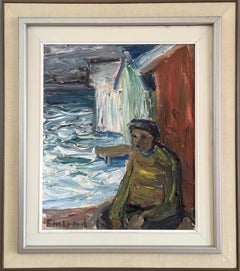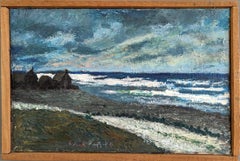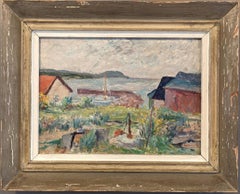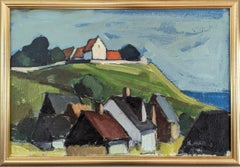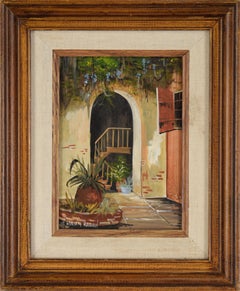Vintage Oil Can
1930s British Vintage Oil Can
Paper
1960s Modern Vintage Oil Can
Canvas, Oil
Mid-20th Century Modern Vintage Oil Can
Oil, Canvas
Mid-20th Century Modern Vintage Oil Can
Canvas, Oil
Mid-20th Century Modern Vintage Oil Can
Canvas, Oil
1980s Modern Vintage Oil Can
Canvas, Oil
Mid-20th Century Modern Vintage Oil Can
Oil, Board
Mid-20th Century Modern Vintage Oil Can
Oil, Canvas
1980s American Impressionist Vintage Oil Can
Oil, Masonite
1970s North American Modern Vintage Oil Can
Canvas, Paint
1960s Modern Vintage Oil Can
Oil, Canvas
1970s American Modern Vintage Oil Can
Canvas, Paint
Mid-20th Century Modern Vintage Oil Can
Board, Oil
Mid-20th Century Modern Vintage Oil Can
Canvas, Oil
20th Century Turkish Moorish Vintage Oil Can
Ceramic
Late 20th Century Turkish Islamic Vintage Oil Can
Ceramic
Mid-20th Century Vintage Oil Can
Walnut
1970s Modern Vintage Oil Can
Canvas, Oil
1960s Modern Vintage Oil Can
Canvas, Oil
Mid-20th Century Modern Vintage Oil Can
Oil, Board
Mid-20th Century Modern Vintage Oil Can
Canvas, Oil
Mid-20th Century Modern Vintage Oil Can
Oil, Canvas
1960s Modern Vintage Oil Can
Oil, Canvas
1960s Modern Vintage Oil Can
Oil, Canvas
1990s Post-Modern Vintage Oil Can
Paint
1960s Modern Vintage Oil Can
Canvas, Oil
Mid-20th Century Modern Vintage Oil Can
Oil, Board
Mid-20th Century Modern Vintage Oil Can
Oil, Canvas
Mid-20th Century Modern Vintage Oil Can
Oil, Board
1960s Modern Vintage Oil Can
Canvas, Oil
Mid-20th Century Modern Vintage Oil Can
Oil, Canvas
Mid-20th Century Modern Vintage Oil Can
Oil, Canvas
Late 20th Century Realist Vintage Oil Can
Canvas, Oil
Mid-20th Century Danish Scandinavian Modern Vintage Oil Can
Teak
Mid-20th Century Modern Vintage Oil Can
Canvas, Oil
1960s Modern Vintage Oil Can
Canvas, Oil
1960s Vintage Oil Can
Canvas
1960s Modern Vintage Oil Can
Canvas, Oil
1960s Modern Vintage Oil Can
Oil, Canvas
Mid-20th Century American Vintage Oil Can
Pottery
Mid-20th Century Modern Vintage Oil Can
Oil, Canvas
1960s Modern Vintage Oil Can
Canvas, Oil
Mid-20th Century Modern Vintage Oil Can
Oil, Board
1960s Modern Vintage Oil Can
Canvas, Oil
Mid-20th Century Modern Vintage Oil Can
Canvas, Oil
Mid-20th Century Modern Vintage Oil Can
Board, Oil
1960s Modern Vintage Oil Can
Board, Oil
1950s Modern Vintage Oil Can
Canvas, Oil
1960s Modern Vintage Oil Can
Canvas, Oil
Mid-20th Century Modern Vintage Oil Can
Canvas, Oil
Mid-20th Century Vintage Oil Can
Faux Leather, Teak
Mid-20th Century Modern Vintage Oil Can
Oil, Board, Canvas
1960s Abstract Expressionist Vintage Oil Can
Oil, Board
1960s Modern Vintage Oil Can
Canvas, Oil
1940s Modern Vintage Oil Can
Board, Oil
1960s Modern Vintage Oil Can
Board, Oil
1960s Modern Vintage Oil Can
Oil, Board, Canvas
1980s Modern Vintage Oil Can
Oil, Canvas
1960s Modern Vintage Oil Can
Oil, Board
1970s Contemporary Vintage Oil Can
Diamond, White Diamond, Emerald, 18k Gold, White Gold
- 1
- ...
Vintage Oil Can For Sale on 1stDibs
How Much is a Vintage Oil Can?
- 1stDibs ExpertSeptember 25, 2019
Clean an oil painting by dusting it with a natural-hair artists’ brush.
- 1stDibs ExpertApril 5, 2022To tell if an emerald has been oiled, look for white or yellow branch patterns along the surface of the gem. If you see them, the gem is likely oiled. Also, examine it under a magnifying glass for any signs of trapped bubbles. These also indicate an oiled gemstone. Consulting a licensed jewelry appraiser is the best way to accurately identify oiled emeralds. You'll find a collection of expertly vetted emerald gemstone jewelry on 1stDibs.
- What is abstract oil painting?1 AnswerLilac Gallery Ltd.March 17, 2021An abstract oil painting and an artwork that is made with oil paint on a medium like canvas, wood board, or other panels like canvas board. And the 'abstract' term refers to the Movement & Style of the piece. As abstraction indicates a departure from reality in the depiction of imagery in art, the artist creates a painting where the subject, shape, form, color, and line, is created with no particular references of the world but as a composition that may exist with a degree of independence from its vision.
- 1stDibs ExpertMarch 22, 2024To maintain oil paintings that you purchased for your home, experts suggest that you keep them out of direct sunlight. Prolonged exposure to the sunlight coming in from a window can fade the colors in your painting. Do not hang your oil painting near a heat source or where it can get wet (bathrooms and kitchens are not safe for your oil painting).
You may wish to dust your oil painting so that layers of dust don’t begin to gather on its surface. This should only be considered to remove loose dust. Never spray any chemical substance on your oil painting. Do not use a damp cloth to dust your oil painting. (Again, your painting should not be exposed to moisture.)
To remove loose dust, use a soft brush that measures approximately one to two inches wide with natural-hair bristles. Do not use a dust cloth or a feather duster, as those items may catch or leave threads or feathers behind. Do not apply pressure or dust your painting for an extended period of time.
If you think that your oil painting is considerably dirty or believe that other issues may be at work, experts strongly suggest that you consult with a professional conservator.
Read about how to arrange your wall art and find oil paintings for sale on 1stDibs. - Do emeralds need to be oiled?1 Answer1stDibs ExpertApril 5, 2022Yes, natural emeralds need to be oiled. Natural emeralds will have cracks and fissures before treatment, and oils will help give the emerald a high sheen and attractive finish. Browse a wide selection of emerald jewelry pieces from some of the world’s top sellers on 1stDibs.
- What does no oil emerald mean?1 Answer1stDibs ExpertApril 5, 2022A no oil emerald is an emerald that has not been treated with oil. Generally, emeralds are oiled to fill in fractures and enhance clarity. A no oil emerald is considered rare and more valuable than standard emeralds. Shop a collection of no oil emerald jewelry on 1stDibs.
- What is a whale oil lamp?1 Answer1stDibs ExpertOctober 12, 2021A whale oil lamp is a lamp that uses whale oil for fuel. Whale oil lamps were largely made from the 16th to the 19th centuries. Antique whale oil lamps are collectibles today and an older specimen will be a striking addition to your mantel or display cabinet. Find a collection of antique and vintage whale oil lamps on 1stDibs today.
- 1stDibs ExpertFebruary 13, 2024To identify an oil painting, look closely at its surface. Compared to other paintings, pieces produced in oils usually show off a variety of textures across the canvas, and the paint will appear layered on. If you're looking to determine the name, age or creator of a work, try snapping a photo with your smartphone’s camera and conducting a reverse image search online. Shop a diverse assortment of oil paintings on 1stDibs.
- When was oil paint invented?1 Answer1stDibs ExpertFebruary 27, 2024Oil paint was invented during the 7th century A.D. The earliest examples of oil paintings have been traced to Afghanistan and depict scenes related to the Buddhist religion. Records dating back to the 12th century indicate that early Christian monks in Europe used oil paints to decorate furniture, and a century later, some artists began finishing tempera paintings with touches of oil paint. It wasn't until the 15th century that oil paints became a common medium for European painters, when Flemish artists like Jan van Eyck began favoring them over tempera. Explore a variety of oil paintings on 1stDibs.
- 1stDibs ExpertSeptember 25, 2019
Butcher blocks should be oiled whenever the wood begins to look dry or chalky.
- 1stDibs ExpertApril 5, 2022There are a few key things to look for to identify an antique oil lamp. First check for a patent number anywhere on your lamp. Use a black light to inspect whether your lamp’s hardware is secured with glue, which fluoresces and would indicate a contemporary lamp. Antique lamps use plaster to attach hardware and fill gaps. An antique oil lamp may have hand-blown glass. Shop a range of professionally authenticated antique oil lamps on 1stDibs.
- 1stDibs ExpertApril 5, 2022To find the artist of an oil painting, look on the back of the canvas. Sometimes, you will find the artist’s name and the year of production on the back. If the canvas is in a frame, gently peel away the paper covering the back to access the canvas. In the event you cannot find any identifying information, seek the help of a licensed art appraiser. Shop a selection of oil paintings on 1stDibs.
- La ChrysomeleFebruary 24, 2021Any artwork is worth and only worth the price someone is willing to pay for it (unfortunately, whether one can afford it or not is another story). Different people may have different reasons to attribute value to an artwork, from the purest (falling in love with it) to what is often considered as the most vile (speculation), going through remembrance, pride of ownership, or brag, among other reasons. For most living artists, the price of the artworks is usually set by the artist and/or the gallery which represent him or her, by type and size of artwork, and corresponds to an equilibrium price between the rate at which artworks are sold and the rate at which new artworks are produced by the artist. For artworks from dead artists sold by professional dealers, the price is often based on auctions results for similar pieces of the same artists. Oil paintings are usually pricier than other techniques because it is considered more difficult to master, but also because oil paintings are known for their ability to last centuries.
- 1stDibs ExpertApril 5, 2022To use vinegar and oil cruets, fill one with your preferred salad oil and one with your preferred salad vinegar. Then drizzle onto salads or other foods to taste. You'll find a collection of vintage and antique vinegar and oil cruets on 1stDibs.
- 1stDibs ExpertApril 5, 2022To tell if your oil painting is authentic, first check the signature of the artist to start your research. Use a magnifying glass to check the texture of the painting, and finally check the back for the painting’s original stretchers. Shop a selection of expertly vetted artwork from some of the world’s top art dealers on 1stDibs.
- How does a Roman oil lamp work?1 Answer1stDibs ExpertAugust 24, 2021Roman oil lamps are simply containers filled with oil, in which a wick made up of cloth or rope rests on one end. The other end of the wick comes in contact with the air. When the wick is lit, the oil in it burns and gives out light.
- 1stDibs ExpertFebruary 13, 2023Because the value of an oil painting can vary greatly based on the artist, the subject and the condition of the piece, it's generally best to work with a certified appraiser. A knowledgeable professional can evaluate the piece and estimate its value. Shop a variety of authentic oil paintings from some of the world’s top galleries on 1stDibs.
- 1stDibs ExpertApril 5, 2022The best place to find oil paintings and discover new artists is at local art galleries. There are also many online art dealers who provide information about artists and sell their works. On 1stDibs, you’ll discover a variety of art styles from master oil painters.
- 1stDibs ExpertMarch 22, 2024Yes, sunlight affects oil paintings. Keep your oil paintings away from direct sunlight.
To maintain oil paintings that you purchased for your home, experts suggest that you keep them out of sunlight. Prolonged exposure to the sunlight coming in from a window can fade the colors in your painting. Do not hang your oil painting near a heat source or where it can get wet (bathrooms and kitchens are not safe for your oil painting).
You may wish to dust your oil painting so that layers of dust don’t begin to gather on its surface. This should only be considered to remove loose dust. Never spray any chemical substance on your oil painting. Do not use a damp cloth to dust your oil painting. (Again, your painting should not be exposed to moisture.)
To remove loose dust, use a soft brush that measures approximately one to two inches wide with natural-hair bristles. Do not use a dust cloth or a feather duster, as those items may catch or leave threads or feathers behind. Do not apply pressure or dust your painting for an extended period of time.
If you think that your oil painting is considerably dirty or believe that other issues may be at work, experts strongly suggest that you consult with a professional conservator.
Read about how to arrange your wall art and find oil paintings for sale on 1stDibs. - How much do oil paintings cost?1 Answer1stDibs ExpertSeptember 25, 2019
On 1stdibs, oil paintings cost between $60 and $6,200,000.
Read More
Art Brings the Drama in These Intriguing 1stDibs 50 Spaces
The world’s top designers explain how they display art to elicit the natural (and supernatural) energy of home interiors.
Welcome (Back) to the Wild, Wonderful World of Walasse Ting
Americans are rediscovering the globe-trotting painter and poet, who was connected to all sorts of art movements across a long and varied career.
In Francks Deceus’s ‘Mumbo Jumbo #5,’ the Black Experience Is . . . Complicated
Despite the obstacles, the piece’s protagonist navigates the chaos without losing his humanity.
With Works Like ‘Yours Truly,’ Arthur Dove Pioneered Abstract Art in America
New York gallery Hirschl & Adler is exhibiting the bold composition by Dove — who’s hailed as the first American abstract painter — at this year’s Winter Show.
Donald Martiny’s Jumbo Brushstrokes Magnify the Undeniable Personality of Paint
How can a few simple gestures — writ extra, extra, extra large — contain so much beauty and drama?
Patrick Hughes’s 3D Painting Takes Us on a Magical Journey through Pop Art History
The illusions — and allusions — never end in this mind-boggling portrayal of an all-star Pop art show on a beach.
Mid-Century Americans Didn’t Know Antonio Petruccelli’s Name, but They Sure Knew His Art
The New York artist created covers for the nation’s most illustrious magazines. Now, the originals are on display as fine art.
Learn Why There Have Been So Many Great Women Painters
Featuring iconic works by more than 300 female artists, a new book makes a more than compelling case for casting off the patriarchal handcuffs that have bound the art historical canon for far too long.
